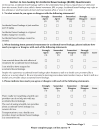Validation of an instrument to assess barriers to care-seeking for accidental bowel leakage in women: the BCABL questionnaire
- PMID: 28236039
- PMCID: PMC5568984
- DOI: 10.1007/s00192-016-3261-8
Validation of an instrument to assess barriers to care-seeking for accidental bowel leakage in women: the BCABL questionnaire
Abstract
Introduction and hypothesis: Fewer than 30% of women with accidental bowel leakage (ABL) seek care, despite the existence of effective, minimally invasive therapies. We developed and validated a condition-specific instrument to assess barriers to care-seeking for ABL in women.
Methods: Adult women with ABL completed an electronic survey about condition severity, patient activation, previous care-seeking, and demographics. The Barriers to Care-seeking for Accidental Bowel Leakage (BCABL) instrument contained 42 potential items completed at baseline and again 2 weeks later. Paired t tests evaluated test-retest reliability. Factor analysis evaluated factor structure and guided item retention. Cronbach's alpha evaluated internal consistency. Within and across factor item means generated a summary BCABL score used to evaluate scale validity with six external criterion measures.
Results: Among 1,677 click-throughs, 736 (44%) entered the survey; 95% of eligible female respondents (427 out of 458) provided complete data. Fifty-three percent of respondents had previously sought care for their ABL; median age was 62 years (range 27-89); mean Vaizey score was 12.8 (SD = 5.0), indicating moderate to severe ABL. Test-retest reliability was excellent for all items. Factor extraction via oblique rotation resulted in the final structure of 16 items in six domains, within which internal consistency was high. All six external criterion measures correlated significantly with BCABL score.
Conclusions: The BCABL questionnaire, with 16 items mapping to six domains, has excellent criterion validity and test-retest reliability when administered electronically in women with ABL. The BCABL can be used to identify care-seeking barriers for ABL in different populations, inform targeted interventions, and measure their effectiveness.
Keywords: Accidental bowel leakage; Barriers; Care-seeking; Fecal incontinence; Help-seeking; Validation.
Figures
Comment in
-
Towards a more scientific approach to measuring barriers to seeking health care in women with fecal incontinence: the BCABL questionnaire.Int Urogynecol J. 2017 Apr;28(4):505-506. doi: 10.1007/s00192-017-3287-6. Epub 2017 Feb 10. Int Urogynecol J. 2017. PMID: 28188467 No abstract available.
Similar articles
-
Barriers to seeking care for accidental bowel leakage: a qualitative study.Int Urogynecol J. 2017 Apr;28(4):543-551. doi: 10.1007/s00192-016-3195-1. Epub 2016 Nov 14. Int Urogynecol J. 2017. PMID: 27844123 Free PMC article.
-
Psychometric evaluation of an online and paper accidental bowel leakage questionnaire: The ICIQ-B questionnaire.Neurourol Urodyn. 2017 Jan;36(1):166-170. doi: 10.1002/nau.22905. Epub 2015 Oct 16. Neurourol Urodyn. 2017. PMID: 26473313
-
Factors associated with care seeking among women with accidental bowel leakage.Female Pelvic Med Reconstr Surg. 2013 Mar-Apr;19(2):66-71. doi: 10.1097/SPV.0b013e31828016d3. Female Pelvic Med Reconstr Surg. 2013. PMID: 23442502
-
Quality of life impact in women with accidental bowel leakage.Int J Clin Pract. 2012 Nov;66(11):1109-16. doi: 10.1111/ijcp.12017. Int J Clin Pract. 2012. PMID: 23067035
-
Development of the Barriers to Error Disclosure Assessment Tool.J Patient Saf. 2021 Aug 1;17(5):363-374. doi: 10.1097/PTS.0000000000000331. J Patient Saf. 2021. PMID: 28671908 Free PMC article. Review.
Cited by
-
Reasons Behind Preferences for Community-Based Continence Promotion.Female Pelvic Med Reconstr Surg. 2020 Jul;26(7):425-430. doi: 10.1097/SPV.0000000000000806. Female Pelvic Med Reconstr Surg. 2020. PMID: 32217918 Free PMC article.
-
Men and women experience different barriers to care seeking for fecal incontinence.Neurourol Urodyn. 2023 Nov;42(8):1769-1776. doi: 10.1002/nau.25266. Epub 2023 Aug 23. Neurourol Urodyn. 2023. PMID: 37614056 Free PMC article.
-
Small-Group, Community-Member Intervention for Urinary and Bowel Incontinence: A Randomized Controlled Trial.Obstet Gynecol. 2019 Sep;134(3):600-610. doi: 10.1097/AOG.0000000000003422. Obstet Gynecol. 2019. PMID: 31403596 Free PMC article. Clinical Trial.
-
Towards a more scientific approach to measuring barriers to seeking health care in women with fecal incontinence: the BCABL questionnaire.Int Urogynecol J. 2017 Apr;28(4):505-506. doi: 10.1007/s00192-017-3287-6. Epub 2017 Feb 10. Int Urogynecol J. 2017. PMID: 28188467 No abstract available.
References
-
- Brown HW, Wexner SD, Segall MM, Brezoczky KL, Lukacz ES. Quality of life impact in women with accidental bowel leakage. Int J Clin Pract. 2012;66(11):1109–16. - PubMed
-
- Brown HW, Wexner SD, Segall MM, Brezoczky KL, Lukacz ES. Accidental bowel leakage in the mature women’s health study: prevalence and predictors. Int J Clin Pract. 2012;66(11):1101–8. - PubMed
-
- Xu X, Menees SB, Zochowski MK, Fenner DE. Economic cost of fecal incontinence. Dis Colon Rectum. 2012;55(5):586–98. - PubMed
-
- Brown HW, Wexner SD, Lukacz ES. Factors associated with care seeking among women with accidental bowel leakage. Female Pelvic Med Reconstr Surg. 2013;19(2):66–71. - PubMed
Publication types
MeSH terms
Grants and funding
LinkOut - more resources
Full Text Sources
Other Literature Sources
Miscellaneous


